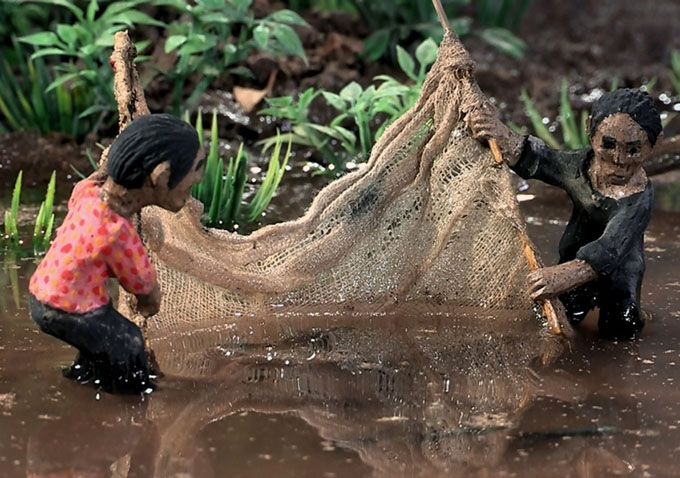
Part documentary, part autobiographical art experiment and part defiant act of memorialization, it’s easy to see why Cambodian film “The Missing Picture,” which screens at the Göteborg International Film Festival this week, now occupies an Oscar nomination slot for Best Foreign Language Film (as we’d tipped it might). The combination of its novel, hand-crafted approach with a story that on the wide-angle level awakens the sleeping horror of an unforgivably underreported genocide, and on the personal level reads as a rending, piercing cri de coeur, is undeniably powerful and provocative, and brought the film the top prize from the Un Certain Regard sidebar in Cannes. And if some elements are more successful than others in achieving a balance between the public and the private, between the story of a nation’s ruination and that of a family’s annihilation, it remains a shocking, poignant and soulful tribute to lives ended and to innocence lost in the country’s notorious Killing Fields.

Director Rithy Panh recreates his own memories of this turbulent period in his country’s history through the unusual medium of elaborate diorama-style tableaux of scenes from his childhood (he was 13 when the Khmer Rouge seized power), populated with hundreds of small figurines of men, women, children, babies and animals, handmade from clay and then handpainted. He then films these static scenes, often featuring representations of himself and his family members, cutting from close ups to wides, even tracking or panning, while in voiceover the narration contextualizes what we’re seeing and ruminates on its meaning. Elsewhere he employs black-and-white documentary footage, some of it incredibly upsetting, to tell fragments of the wider story while cutting back to live-action close-ups of the little clay dolls being sculpted. And he also occasionally crudely superimposes archive clips from the glamorized, escapist pre-coup Cambodian films he watched being made as a kid and which come to represent the carefree, brightly colored childhood that came to such an abrupt end in 1975. It’s a fascinating example of storytelling and documentary techniques being used in concert and occasionally in collision to produce something that, whether it completely works on all its levels or not, is totally unique and devastatingly personal.
If the film is pursing several, equally worthy agendas, they come together most successfully with the clay figurines, which, in their rough, bluntly crafted simplicity, call to mind everything from memorial statues to Golems to children’s toys. And while the camera moving around and amongst them highlights their static, frozen, and, well, dead nature, it also captures their uniqueness. Here, you can see where the brush might have slipped while dotting in the eyes; there you notice the porous, pitted surface of the dried clay beneath the paint. The painstaking level of detail that goes into these recreations is such that, quite aside from what the scenes represent, you want to go back and rewatch them, to catch the figures you missed the first time round or to wonder at how he achieved the lush vegetation of the background. There is an instant appeal in the idea of being able to create a three-dimensional memory in miniature, and being able to wander around it, to look at it from every angle.

Mainly, though, what the film elicits is horror, all the more pointed for existing in the juxtaposition of these childlike representations and the actual events they stand for. From the 9-year-old child who informs on his mother for stealing mangoes, to the well-fed Khmer Rouge soldiers forbidding the peasants (i.e. everyone not a Khmer Rouge soldier) from digging for roots or fishing from the bountiful streams, to the terrible degradation of the human spirit that results from ceaseless, life-threatening hunger, the film is littered with sickening recollected moments that detail Panh’s existence under a regime that reduced an entire population to slave status and summarily killed those who resisted or were even suspected of doing so. But it is a horror that comes home most powerfully when we are prompted to absorb these skewering details, like the fact that the collective ideology permitted the personal ownership of a spoon but not a bowl, for ourselves. In later stages, the constant philosophizing of the narration, delivered in an unchanging sombre monotone, becomes at best unnecessary and at worst a distraction that, through ceaseless intellectualization, blunts the emotional impact of what we’re seeing. Similarly the omnipresent score by Marc Marder eventually becomes an irritation in how insistently it reminds us how we should be feeling.
This heavy signposting aside, in trying to find a cathartic correlation between filmmaking and memorializing, fiction and truth, history and memory, the film has been compared to “The Act of Killing,” the also Oscar-nominated (though in the Documentary category) evocation of another South-East Asian genocide overlooked by the West. But Panh’s movie has a different slant from Oppenheimer’s; it is as much a sorrowful personal meditation on the brutal rupturing end of his childhood and an expiation of a heartbreaking kind of survivor’s guilt as it is an excoriating education in Cambodia’s shameful past. As such it has a more elegiac tone, that of a reflective man in later life, haunted by ghosts that work themselves into clay through his fingers. In the end, it is such a deeply personal work that we may feel that we know the filmmaker almost better than we know his story or that of the episode that lies like a scar across the history of the region, but that nonetheless makes “The Missing Picture” a small but important part of a larger, unfinished mosaic. [B]

